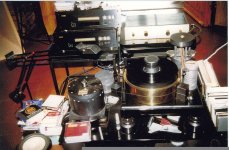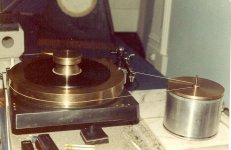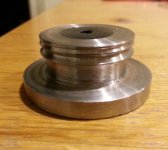Joachim,
To take that mass from a standing start up to rotational speed must take an extreme amount of torque to just get it moving.
You 'hand-start' them (most string driven heavyweight platters)...before turning motor on.
Yes, the 500kG table is absurd but it drew a lot of attention. The designer was really proud of it. He said it is a one off for a "special" customer anyway.
The High End is full of those stories but it worked just fine nevertheless.
I was so shocked that i forgot how they drive it. I can call them if you want though.
I also asume it needs a hand push.
The High End is full of those stories but it worked just fine nevertheless.
I was so shocked that i forgot how they drive it. I can call them if you want though.
I also asume it needs a hand push.
Yes, the 500kG table is absurd but it drew a lot of attention. The designer was really proud of it. He said it is a one off for a "special" customer anyway.
The High End is full of those stories but it worked just fine nevertheless.
I was so shocked that i forgot how they drive it. I can call them if you want though.
I also asume it needs a hand push.
I'd go with 12 pancake coils underneath, drive them 3 phase in 4 sets, let the eddy currents turn the darn thing.. It's not like the field is going to make it up to the cart, right??
jn
..........
I also asume it needs a hand push.
As does this. The platter is pure graphite with an enormous outer mass ring. The whole platter literally floats on a bed of air, the only contact being the drive string. [The original arm was a pantograph parallel tracker made from pure graphite and held together by needle and gemstone bearings. I have a olour slide somewhere but cant find it at the moment]. A few of these TTs were made by Be Yamamura.
The second pic is of a simple air-lift version to test graphite as a platter material. The motor position seems unusual.
Attachments
FWIW, concept a bit premature. Testing has only been done on Hurst AC motors.
For belt driven tables, dual belt pulley running on different speeds/diameter e.g. 33.4 and 33.1. I don't remember the actual numbers. The "faster" or drive belt is rigid or non-stretching and the "slower" or drag belt is latex/rubber/neoprene. Speed was very stable at 33.33 with only the supplied capacitors and AC mains. Worked very well, no detectable "cogging." Also required less belt tension to drive platter.
Have fun. Happy listening.
For belt driven tables, dual belt pulley running on different speeds/diameter e.g. 33.4 and 33.1. I don't remember the actual numbers. The "faster" or drive belt is rigid or non-stretching and the "slower" or drag belt is latex/rubber/neoprene. Speed was very stable at 33.33 with only the supplied capacitors and AC mains. Worked very well, no detectable "cogging." Also required less belt tension to drive platter.
Have fun. Happy listening.
Sepics,
So are you saying that the secondary belt was slipping or was there something else that would average the speed of the two different drive belts? Was it a stepped capstan with two slightly different diameters?
So are you saying that the secondary belt was slipping or was there something else that would average the speed of the two different drive belts? Was it a stepped capstan with two slightly different diameters?
I was not able to thoroughly test. However, I would hazard a guess it was the lurching and lagging of the motor that averaged the speed not slipping. The drive belt a string, run 33.4-33.5 by itself, now that I think about. The drag belt was latex, it might have been from a VPI. The motor was a 300 rpm hurst. The platter was no more than 7-8 pounds made out of maple.
Anyway, here is one of the prototypes.
Anyway, here is one of the prototypes.
Attachments
Today i set the VTA straight and it happened what i expected.
The soundstage develops very similar now to what i hear when i do not use the felt pad to lift the record off the platter. I like the resulting sound, again a bit less annoyance from scratches and a somewhat more mellow and round tone.
It is too early to tell but this is a method worth investigating when we do not want to put the record direct on the brass platter.
Dirt cheep and easy too.
Tomorrow i will post some pictures.
The soundstage develops very similar now to what i hear when i do not use the felt pad to lift the record off the platter. I like the resulting sound, again a bit less annoyance from scratches and a somewhat more mellow and round tone.
It is too early to tell but this is a method worth investigating when we do not want to put the record direct on the brass platter.
Dirt cheep and easy too.
Tomorrow i will post some pictures.
Yes, the 500kG table is absurd but it drew a lot of attention. The designer was really proud of it. He said it is a one off for a "special" customer anyway.
The High End is full of those stories but it worked just fine nevertheless.
I was so shocked that i forgot how they drive it. I can call them if you want though.
I also asume it needs a hand push.
Joachim
what bearing use R&S with this platter - would be interesting. Did you read the article from Götz Wilimzig about turntable drives? I have some drives here, stepper motor with controller / BLDC-motors & DC-motors, and make my experiences with them.
If you like you can contact me and we can discuss some topics.
Last edited:
Wouldn't you be better off using a bearing with a Viton seal that would cause the drag?
Just use heavy oil/silicon fluid in the bearing- it has no noise, better than any seal.
Last edited by a moderator:
I know Götz very well. He started his experiments back in the 80th but i do not know what he is doing now. Could call him up.
I know Götz very well. He started his experiments back in the 80th but i do not know what he is doing now. Could call him up.
Would be interesting to know what he's doing now...
Maybe a too heavy platter weight, for example above 25kg, would not bring more sonic benefits. Like you described you can use magnets supporting the ball of spindle. To my experience the sound without magnet is more grounded and the bass is more accurate. Mostly overlooked ist the oil, use a special oil which is designed for low rotation.
I've had long term experience of three decks with easily removable magnet assemblies. In no case has the non-magnet version sounded more 'grounded'. All I've ever heard is about 3db less noise.
Do you find wooden parts sound organic and that silver cables sound bright? ;-)
I have heard a magnetic bearing implementation where bass was lost. This was traced to a misalignment in the magnets causing the platter to bump upwards by about .5mm twice every resolution. The 66hz modulation this caused was most easily identified in the lower registers.
Do you find wooden parts sound organic and that silver cables sound bright? ;-)
I have heard a magnetic bearing implementation where bass was lost. This was traced to a misalignment in the magnets causing the platter to bump upwards by about .5mm twice every resolution. The 66hz modulation this caused was most easily identified in the lower registers.
Basis tt's AJ Conti talked about the belt variarions and its effects on speed variations compared to different platter weights and so forth.
His " measurements. " showed signifcant differences from a ground toleranced belt verses a common style belt either an o ring or basic flat belt that everyone seems to take for granted. One of the Hiend mag interviews talked about this awhile back
If you have ever had a conversation with him you can appreciate his no BS style of information devoid of emotional backpacking trips into the mountain air.
Regards
David
His " measurements. " showed signifcant differences from a ground toleranced belt verses a common style belt either an o ring or basic flat belt that everyone seems to take for granted. One of the Hiend mag interviews talked about this awhile back
If you have ever had a conversation with him you can appreciate his no BS style of information devoid of emotional backpacking trips into the mountain air.
Regards
David
I know that the belt should be really without any mechanical defects, like the one i have shown in post 157. Where the opposites meet it will never be totally perfect.
I can measure this with Dr.Feikert Adjust+ on my SG1 as a slight speed "jump" when the seam rolls over the pulley, even with the high mass, flywheel platter of the SG1.
A cast ( one piece ) belt did not show this defect but where to get one ?
I can measure this with Dr.Feikert Adjust+ on my SG1 as a slight speed "jump" when the seam rolls over the pulley, even with the high mass, flywheel platter of the SG1.
A cast ( one piece ) belt did not show this defect but where to get one ?
Any measurements of a tape belt vs a string? Would be interested in this...
Are you happy with Chris' Adjust+ ?
Are you happy with Chris' Adjust+ ?
- Status
- Not open for further replies.
- Home
- Source & Line
- Analogue Source
- The Good Turntable


